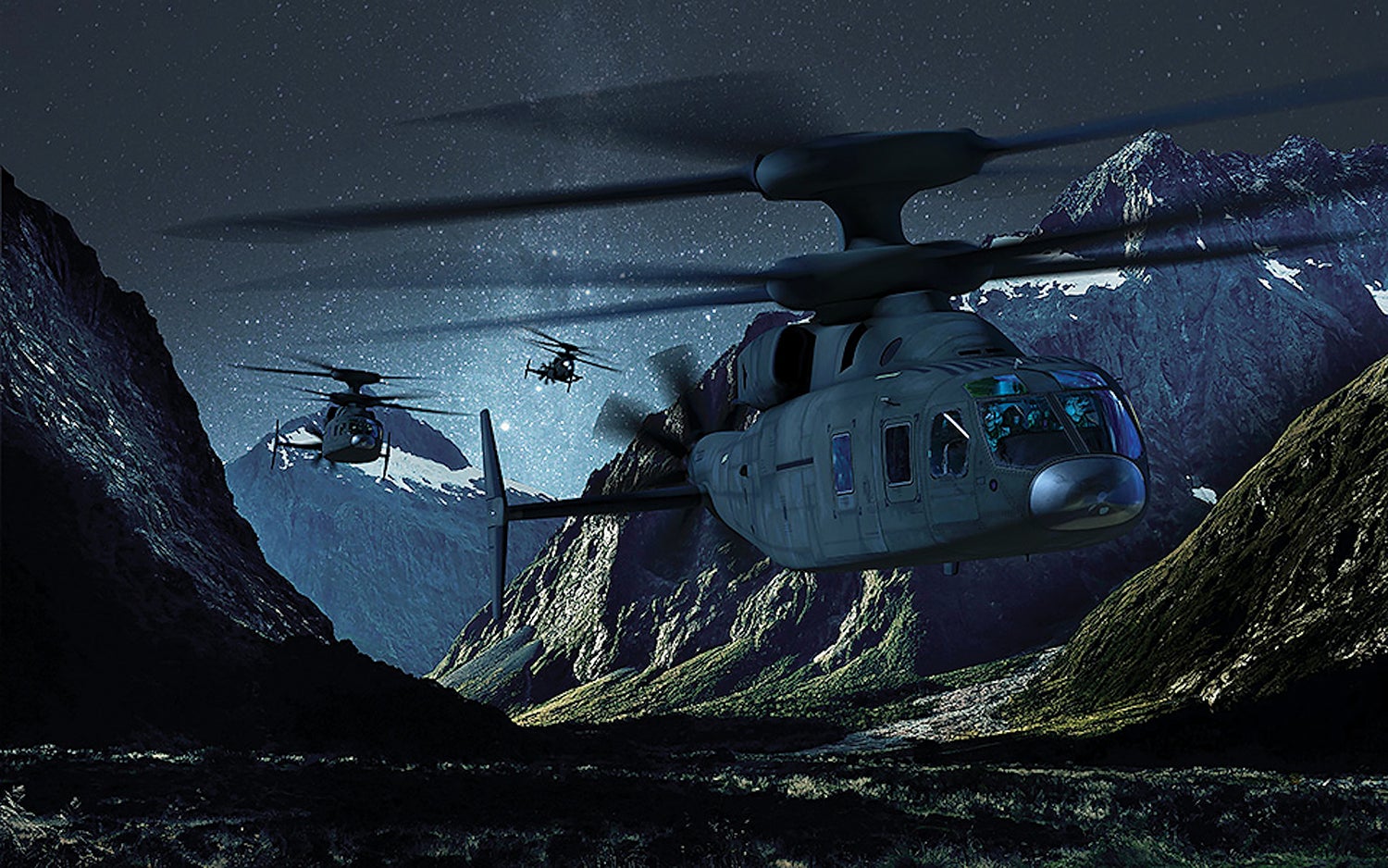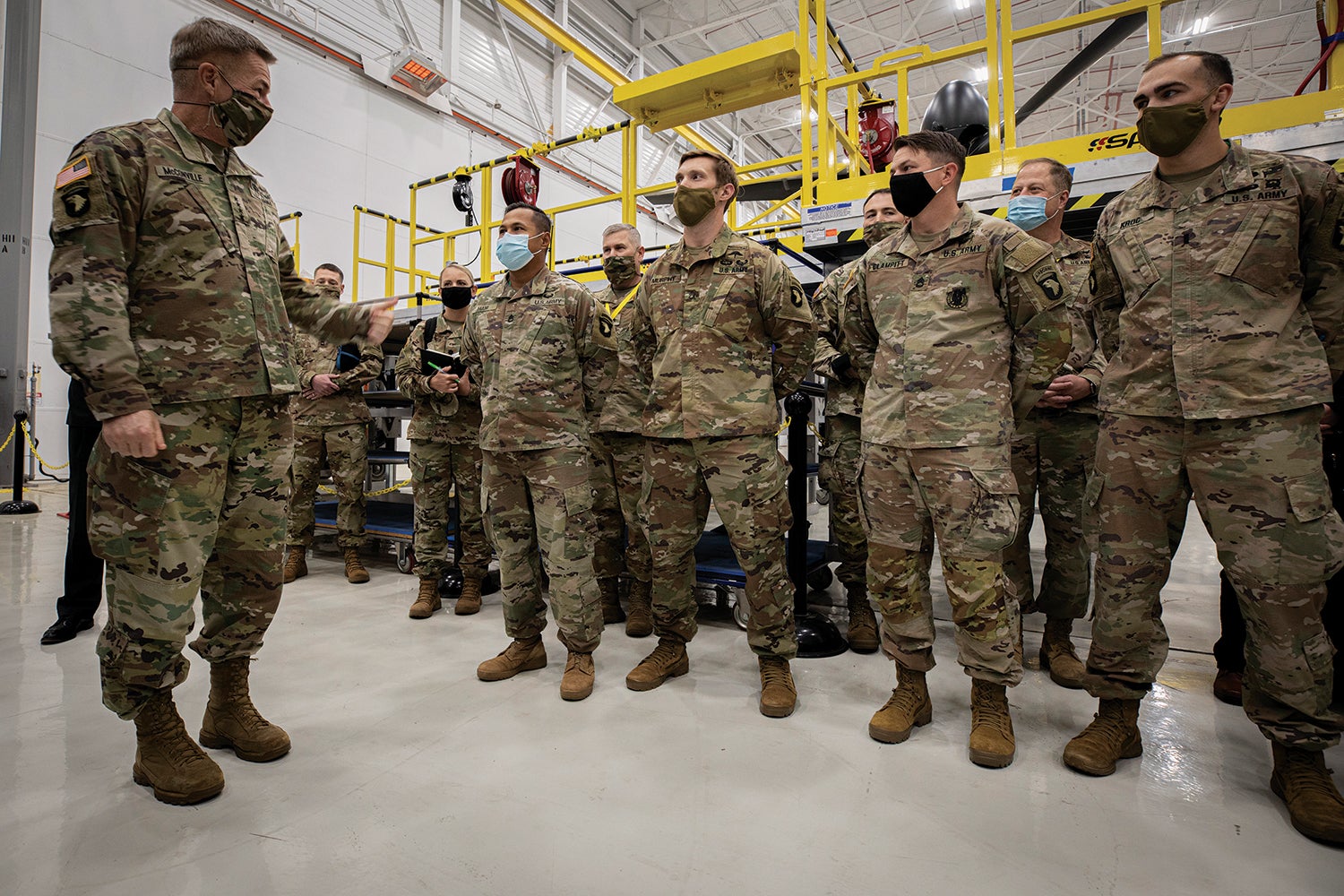The Army’s Future Vertical Lift aircraft will provide the joint force with flexible, agile and decisive options based on next-generation technological advancements as well as advanced tactics and teaming. Future Vertical Lift will feature transformational speed, range and endurance to generate strategic and operational advantages, operate from a place of relative sanctuary and rapidly deliver combat power to the tactical edge of the battlefield.
Next-generation technological advancements and Future Vertical Lift’s modular open systems approach set the conditions for interoperability and convergence within joint integrated fires and intelligence environments to enable expanded maneuver. Future Vertical Lift (FVL) provides the joint force commander with critical Army aviation capabilities to achieve decisive results while creating multiple dilemmas for the enemy.
To maximize capabilities presented by revolutionary FVL capabilities, the Army will modernize training concepts and strategies with adaptive training techniques, advancements in technology and modernized training systems to rapidly build readiness.

Innovative Approach
FVL will use existing training methods and infrastructure to the maximum extent possible while taking advantage of innovative training technologies and advanced training techniques. The FVL training approach includes a front-end analysis of training requirements necessary to meet the program’s rapid acquisition strategy. This front-end analysis facilitates Army aviation’s early assessment and identification of key system attributes unique to the aircraft. Training developers then can identify training techniques and systems to develop knowledge, skills and tasks that aviation personnel will require for operating, maintaining and supporting FVL.
This developing training strategy will ensure individuals and FVL units can effectively employ FVL capabilities on the future battlefield to build readiness. Key components of the FVL training strategy include institutional training; unit training; training aids, devices, simulators and simulations; ranges; and hands-on skills training. The strategy will support FVL operators and maintainers, and support MOS training programs while increasing individual skills and proficiencies to ensure aircraft availability and aircrew competencies for follow-on collective training.

The FVL integrated training concept will support initial qualification, fielding and training of FVL to units. Soldiers will train at current institutional training locations and ensure task proficiency. They will gain task proficiency through traditional classroom, demonstration and hands-on methods, and by incorporating future innovative training techniques and media. The media will include computer-based training/computer-aided instruction such as collaboration/simulation classrooms, distributed learning, part-task training devices, full-fidelity mission simulators, embedded training, mixed reality/virtual reality/augmented reality, and hands-on training.
Unit training conceptual framework continues to develop as Army leaders evaluate the most effective method to execute collective training for FVL units maximizing the capabilities of Future Attack Reconnaissance Aircraft and Future Long-Range Assault Aircraft while increasing readiness. Training locations, ranges and facilities must support the unique requirements FVL brings with its increased speed, range and endurance along with its advanced sensors, munitions and air-launched effects.

Leading the Way
The U.S. Army Aviation Center of Excellence leads the effort to evaluate the most effective method to conduct a collective unit fielding and training program. Utilizing a dedicated organization that provides collective training in key mission profiles at one location, much like those used to field the AH-64 Apache and OH-58D Kiowa helicopters and MQ-1C Gray Eagle unmanned aircraft system, is essential to rapidly building readiness for those fielding units. The center can focus on FVL transformational capabilities during a Regionally Aligned Readiness and Modernization Model cycle to create operationally ready battalion-level units in the shortest time possible.
There are challenges associated with this training concept that training developers and senior leaders must reconcile before making a final decision on how FVL unit training will occur. However, this single unit fielding and training concept aligns within the Regionally Aligned Readiness and Modernization Model cycles, providing an operationally ready battalion for the Army.
The training enterprise continues to analyze, identify and define a training support structure to provide an effective and cost-efficient training program that meets new equipment fielding requirements while preserving readiness for aviation forces. FVL’s training systems will capitalize on the FVL modular open systems approach and digital backbone to enable integration and near-real-time concurrency between the platform and training enterprise. It provides needed information to identify potential advanced training technologies to achieve effective and efficient training solutions in the most cost-efficient manner.
Research and analysis of current and future training technologies, learning science, and operator- and maintainer-related performance is critical to develop training-support solutions for Army aviation formations.
Combining Methods
The future learning environment must evolve to support the training and education requirements of soldiers who operate, maintain and support the FVL aircraft and systems. Soldier training to utilize these advanced systems requires the Army learning environment to leverage advanced technology and systems. The learning products, processes and supporting systems will adapt to support a new mix of capabilities, equipment and learning mediums that capitalize on those advanced technologies.

While many of the traditional means of individual and collective learning will endure, FVL will supplement or replace those means because of improvements in learning science and technology.
Research shows there are advantages to combining training methods along with gaming technologies such as blended training (live, virtual, constructive, gaming). FVL will utilize these technologies. FVL training will include mixed reality, virtual reality and augmented reality to meet technological advancements in training capabilities that support the future learning environment.
The next evolution in advanced training will include linking live, virtual, constructive and gaming training systems together in the synthetic training environment. FVL training development will adapt to new methods of training as learning science evolves and technology advances.
A critical aspect of FVL training is the tactical training interface as part of the embedded training concept. The current Army training environment uses aircraft systems tied through smart data interface modules to transmit aircraft data. The FVL approach leverages open system architectures and embedded training capabilities. This allows FVL to utilize nonhardware solutions to replace current functions while providing data/telemetry solutions. It also integrates other key FVL capabilities such as threat simulation, degraded performance, system malfunctions and mission rehearsals, to name a few. The FVL embedded training interface allows for linkage with the synthetic training environment as both systems continue to progress in capability development.
Utilizing the STE
FVL training will include those capabilities currently under development within the synthetic training environment to ensure compatibility with all Army training systems. The synthetic training environment brings together live and virtual training environments, aiming to deliver accessible exercises that mimic the full complexity of the physical world.
The synthetic training environment, like FVL, will use existing technology advances to transform the fighting force. The synthetic training environment is critical for improving lethality and survivability by enhancing the efficiency and realism of live training, building terrain familiarity, providing mission repetition and simulating combat.
By combining live, virtual, constructive and gaming training environments, the synthetic training environment will provide interoperable training through simulated real-world terrain that includes advanced 3D mapping software, which FVL will leverage.
The synthetic training environment supports needed training, operational capabilities and accessibility in sufficient repetition to be of tremendous value to the force. It allows realistic and dynamic multidomain operations training, including cross-domain, cross-force and multiple-partner convergence. It will improve urban operations training by simulating clutter, crowd dynamics, logistics, long-range fires and cyber and electronic warfare.

As integrated members of the synthetic training environment, aircrews can execute training with other members of the combined arms team located across an installation or at different installations throughout the synthetic-virtual and constructive worlds. The synthetic training environment can make high-consequence training and mission rehearsals far less dangerous and less expensive than traditional force-on-force or live-fire training.
FVL’s simulation-ready architecture replicates the weapon system digital backbone facilitating a training aids, devices, simulators and simulations modular open systems approach-like environment that enables ease of integrating system updates in near-real-time. It also will reduce life cycle costs while accurately replicating the actual handling and engagement qualities of FVL. This allows FVL aircrews to rehearse missions multiple times in complex simulated environments before attempting missions in live training, all without risking life or limb.
The interface capabilities resident within FVL’s training aids, devices, simulators and simulations architecture simplifies integration and “networkability” with other simulation commodities as required by the synthetic training environment. Additionally, the tactical training interface coupled with the embedded training concept and the synthetic training environment will provide an integrated after-action review capability that delivers near-real-time feedback to evaluate application of tactics, techniques and procedures.
Decisive Capability
FVL provides the Army and the joint force with transformational capabilities that increase speed, range, survivability, lethality and sustainment critical to operating in the expanded battlespace envisioned in future conflict.
Prototypes, modeling and analysis highlight the survivable and transformational capability FVL-equipped formations bring to large-scale combat operations. FVL training development solutions will use emerging technologies, synthetic training environment capabilities and innovative training solutions to ensure that operators, maintainers and supporters have the skills necessary to operate in the future environment, all while increasing readiness for the operational commander.
FVL is a decisive capability that presents multiple dilemmas to the enemy and extends tactical commanders’ understanding throughout the depth of the operating environment. The Army will deliver training that maximizes those capabilities to fully support an agile and adaptive expeditionary force that is providing effective and affordable critical overmatch for both the Army and joint forces.
* * *
Col. Joshua Higgins is director of the U.S. Army Aviation Capability Development and Integration Directorate, U.S. Army Futures Command, Fort Rucker, Alabama. He has held numerous leadership and staff assignments, and has commanded at every level up to brigade. He has served three combat deployments. He graduated from the U.S. Military Academy, West Point, New York, in 1995 and holds two master’s degrees, one from Kansas State University and one from the National War College.
Col. Kenneth Hawley, U.S. Army retired, served in the Army for 30 years and is now an aviation specialist in the U.S. Army Aviation Capability Development and Integration Directorate. Before retiring, he held numerous Army and joint staff assignments, and commanded at every level up to brigade. He served two combat deployments. He graduated from West Point in 1990 and has an MBA from Embry-Riddle Aeronautical University and a master’s degree from the Naval War College.

